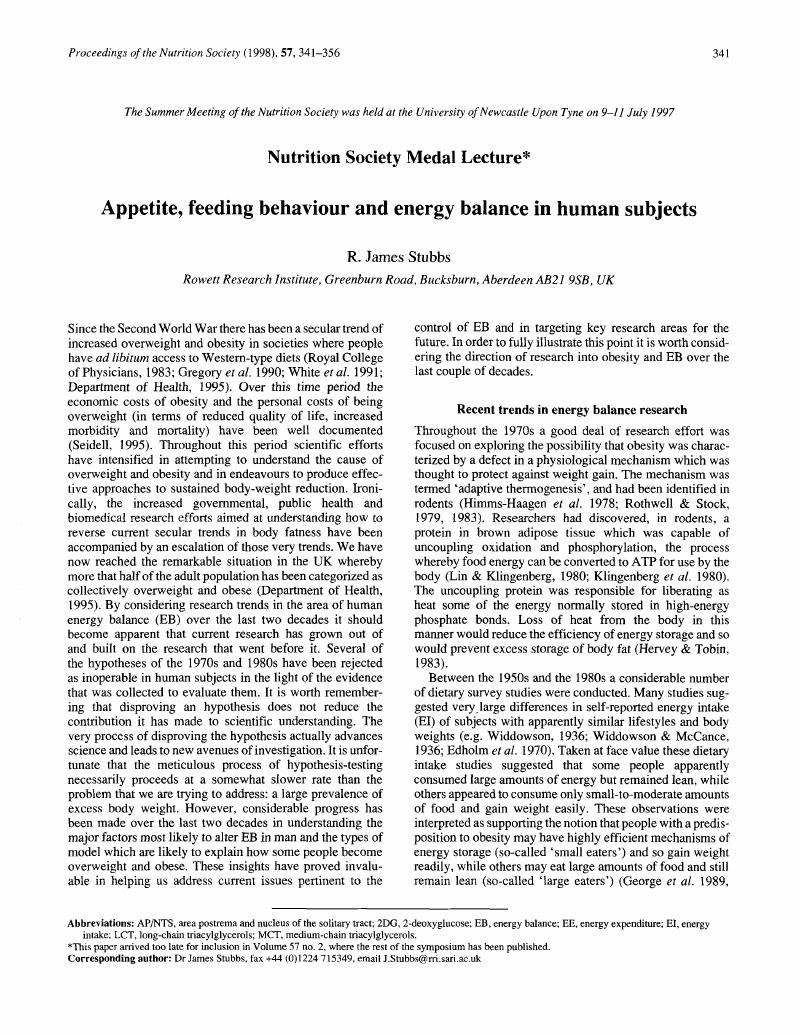Crossref Citations
This article has been cited by the following publications. This list is generated based on data provided by Crossref.
James, W. P. T.
and
Ralph, A.
1999.
New understanding in obesity research.
Proceedings of the Nutrition Society,
Vol. 58,
Issue. 2,
p.
385.
Lammert, Ole
Grunnet, Niels
Faber, Peter
Bjørnsbo, Kirsten Schroll
Dich, John
Larsen, Lis Olesen
Neese, Richard A.
Hellerstein, Marc K.
and
Quistorff, Bjørn
2000.
Effects of isoenergetic overfeeding of either carbohydrate or fat in young men.
British Journal of Nutrition,
Vol. 84,
Issue. 2,
p.
233.
Gibson, SA
2000.
Associations between energy density and macronutrient composition in the diets of pre-school children: sugars vs starch.
International Journal of Obesity,
Vol. 24,
Issue. 5,
p.
633.
Mathey, Marie-Françoise A.M
Zandstra, Elizabeth H
de Graaf, Cees
and
van Staveren, Wya A
2000.
Social and physiological factors affecting food intake in elderly subjects: an experimental comparative study.
Food Quality and Preference,
Vol. 11,
Issue. 5,
p.
397.
King, S.
David, S.
Newton, H.
Hevey, D.
Rafferty, F.
and
Horgan, J.H.
2000.
The effect of dietary modification on the training outcome and body composition in patients undergoing a cardiac rehabilitation programme.
Coronary Health Care,
Vol. 4,
Issue. 2,
p.
76.
Stubbs, R. James
Mazlan, Nik
and
Whybrow, Stephen
2001.
Carbohydrates, Appetite and Feeding Behavior in Humans.
The Journal of Nutrition,
Vol. 131,
Issue. 10,
p.
2775S.
Illius, A. W.
Tolkamp, B. J.
and
Yearsley, J.
2002.
The evolution of the control of food intake.
Proceedings of the Nutrition Society,
Vol. 61,
Issue. 4,
p.
465.
Ulijaszek, Stanley J.
2002.
Human eating behaviour in an evolutionary ecological context.
Proceedings of the Nutrition Society,
Vol. 61,
Issue. 4,
p.
517.
Simpson, Stephen J
Batley, Rachel
and
Raubenheimer∗, David
2003.
Geometric analysis of macronutrient intake in humans: the power of protein?.
Appetite,
Vol. 41,
Issue. 2,
p.
123.
Piers, L. S.
Walker, Karen Z.
Stoney, Rachel M.
Soares, Mario J.
and
O'Dea, Kerin
2003.
Substitution of saturated with monounsaturated fat in a 4-week diet affects body weight and composition of overweight and obese men.
British Journal of Nutrition,
Vol. 90,
Issue. 3,
p.
717.
Soares, MJ
Piers, LS
Walker, KZ
and
O'Dea, K
2003.
Is There a Role for Monounsaturated Fat in the Dietary Management of Obesity?.
Asia Pacific Journal of Public Health,
Vol. 15,
Issue. 1_suppl,
p.
S18.
Del Prete, E.
Lutz, T.A.
and
Scharrer, E.
2004.
Inhibition of glucose oxidation by α-cyano-4-hydroxycinnamic acid stimulates feeding in rats.
Physiology & Behavior,
Vol. 80,
Issue. 4,
p.
489.
Stubbs, R James
Hughes, Darren A
Johnstone, Alexandra M
Horgan, Graham W
King, Neil
and
Blundell, John E
2004.
A decrease in physical activity affects appetite, energy, and nutrient balance in lean men feeding ad libitum.
The American Journal of Clinical Nutrition,
Vol. 79,
Issue. 1,
p.
62.
Whybrow, S.
Mazlan, N.
and
Stubbs, R.J.
2005.
Food, Diet and Obesity.
p.
179.
Whybrow, S.
Mazlan, N.
and
Stubbs, R.J.
2005.
Food, Diet and Obesity.
p.
179.
Al Awar, Rima
Obeid, Omar
Hwalla, Nahla
and
Azar, Sami
2005.
Postprandial acylated ghrelin status following fat and protein manipulation of meals in healthy young women.
Clinical Science,
Vol. 109,
Issue. 4,
p.
405.
Cordain, Loren
Eaton, S Boyd
Sebastian, Anthony
Mann, Neil
Lindeberg, Staffan
Watkins, Bruce A
O’Keefe, James H
and
Brand-Miller, Janette
2005.
Origins and evolution of the Western diet: health implications for the 21st century1,2.
The American Journal of Clinical Nutrition,
Vol. 81,
Issue. 2,
p.
341.
Simpson, S. J.
and
Raubenheimer, D.
2005.
Obesity: the protein leverage hypothesis.
Obesity Reviews,
Vol. 6,
Issue. 2,
p.
133.
Dulloo, Abdul G.
2005.
Clinical Obesity in Adults and Children.
p.
65.
Stubbs, R. J.
and
Tolkamp, B. J.
2006.
Control of energy balance in relation to energy intake and energy expenditure in animals and man: an ecological perspective.
British Journal of Nutrition,
Vol. 95,
Issue. 4,
p.
657.



